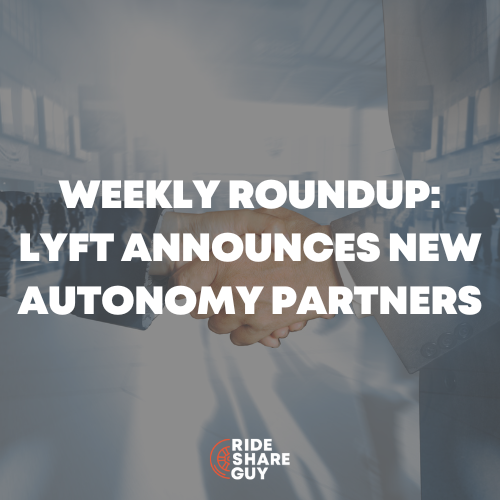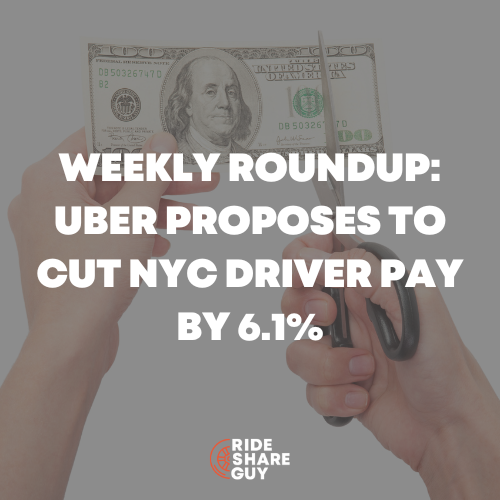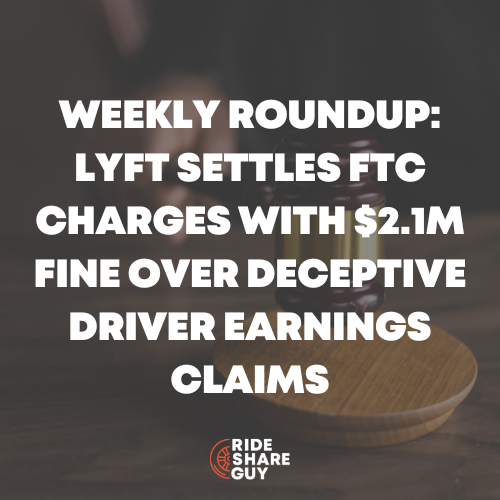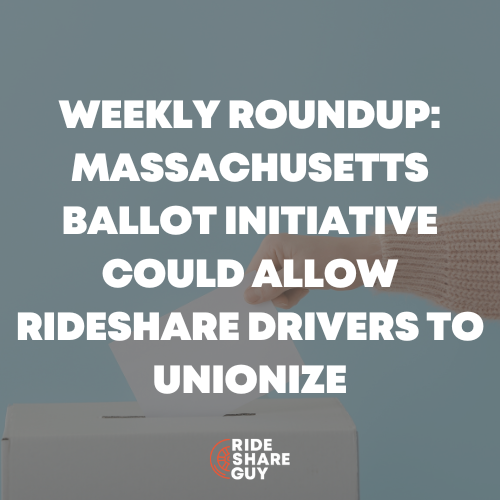There was a lot of media attention around Uber this week, that’s nothing new, but this week, it was a mix of bad and good. Today, RSG contributor, John Ince takes a look at the most popular rideshare stories of the past week.
If you’re wondering about what’s going on with the court case in San Francisco (Uber – employee vs IC), we’ll be doing a full analysis of the hearing and what its potential impact for drivers could be next week. Yesterday’s hearing was to determine if the three drivers bringing the suit against Uber could be turned into a class action that would represent all drivers. The judge didn’t give a final ruling but there were lots of interesting points that came out which we will touch on. So stay tuned!

Uber’s big problem that won’t go away: background checks
Sum and Substance: Child exploitation. DUI. Manslaughter. Those were just some of the criminal convictions on record for four Uber drivers in Los Angeles before they were approved to work as contractors for the ride-hailing service, according to a report Tuesday from the Los Angeles Times based on court records from drivers ticketed at the Los Angeles International Airport.
It is yet another concerning news item on a long list of Uber incidents stretching across the country and the world — and raising concerns about how much Uber, and its users, really know about the drivers who work for the company. Uber drivers have been accused of rape and sexual assault in Dallas, Boston and New Delhi. Legislators from California to Kansas have pushed for stricter background checks on car-hailing services. Even before this week’s report, news organizations had found instances of drivers with criminal pasts passing their background checks.
The $50 billion company has fought tooth and nail to avoid being subject to stricter background check laws.When Kansas pushed a bill in May that would require Uber background checks be handled by the Kansas Bureau of Investigation, Uber rallied its customers and political allies to protest, then temporarily pulled its service from Kansas. Due to the political pressure from Uber, a more favorable bill was ultimately passed.
My Take: This is a potentially explosive issue. I don’t see how Uber can suppress it indefinitely. As incidents surface in the media – and they will because the odds make it an inevitability – Uber will have to come up with some accommodation here rather than reverting to its combat mode.
7 Things You Do That Annoy Your Uber Driver
Sum and Substance: After every Uber ride you take, your driver gives you a rating on a scale from one to five, based on your behavior. That rating is then averaged into your overall passenger score, which drivers consider before they decide whether or not to pick you up. In other words: You don’t want a bad rating.
So we compiled a list of seven things you might be doing to annoy your Uber driver and destroy your rating. Avoid these behaviors to ensure a smooth ride for both you and your driver. 1. You don’t give a five-star rating, even though your ride was perfectly fine. If your ride goes smoothly, you should give your driver a full five-star rating.
Uber expects its drivers to maintain an extremely high average, and drivers can lose their job if their score drops too far. While a spokesperson for Uber told The Huffington Post that the company does not have “a single global threshold below which a driver … is deactivated,” Business Insider reported in February that drivers run the risk of having their account deactivated if they fall below a 4.7 rating.
My Take: This article hits home for anybody who’s been driving for any period of time.
Instacart workers in San Francisco claim they’re being “screwed” by new employee policy
Sum and Substance: Last month, the federal Department of Labor issued a “policy guidance document” addressing the misclassification of employees as contract workers. The memo suggests that federal agencies might begin taking a more active interest in the cadres of independent contractors currently toiling on behalf of the sharing economy.
At the same time, a number of lawsuits have been lodged across the country contending that these contractors are actually misclassified employees. Last week, I reported that Instacart had informed in-store shoppers in San Francisco of the impending status change, giving them only 48 to decide whether to reapply for their jobs.
As part-time employees, the shoppers will be held to a 29-hours-per-week maximum; they will receive a flat wage and no longer be eligible for commissions and tips. Nor will they accrue the paid time off, health-care benefits or advanced scheduling guarantees that help make employment an attractive alternative to contracting. … The primary gripes were that they’re taking a substantial pay-cut, facing a significant decrease in hours, and that the change happened so suddenly and without their input.
My Take: It’s a fairly safe bet that Uber and Lyft have a Plan B in the works if courts ruling against them in the pending cases over employee / independent contractor status. This may be a preview of their Plan B. One thing is for sure – TNCs hold all the cards in any decision as to what the terms of employee agreement will look like. So a win for the drivers in the courts may not translate into a win for the drivers in their pocketbooks.
Here Are the Internal Documents that Prove Uber Is a Money Loser
Sum and Substance: Uber, Silicon Valley’s prized amoral unicorn, is presumed to be a financial titan and a sure-thing IPO in the near future. Which may be true. But one thing that’s frequently missing from the conversation about its inevitable dominance over virtually every facet of our lives is the answer to a fundamental question: Does it make money?
According to internal financial documents obtained by Gawker, the answer is a resounding no. Uber has lost tens of millions of dollars since 2012, and the documents suggest that CEO Travis Kalanick’s boasts about the company’s exponential revenue growth may be overblown. Kalanick rarely skips an opportunity to flog the company’s enormous perceived financial success or herald its meteoric course—in 2012, he told a conference audience “Whenever I have a bad day, I just look at our overall revenue graph.”
In May, the New York Times reported that Uber is in the midst of raising an extra $1.5 billion in venture capital backing … The month before, an undated bonds term sheet viewed by Bloomberg showed operating losses of $415 million. … documents obtained by Gawker demonstrate conclusively for the first time that Uber has been financing its astronomic growth by taking staggering losses.
My Take: These recent leaks do not paint a flattering picture of Uber and their ability to responsibly manage all the investor capital they’ve raised – estimated to be over $5 billion. This is nothing new for Silicon Valley where the pressure on management teams is towards growth rather than profitability. But at some point Uber has to come to grips with their hemorrhaging capital flows. If they’re serious about an IPO … and all indications are that it will be sooner rather than later … they will have to come clean on exactly how much money they’re losing. That may be the time of reckoning for the management team – rather than their time of jubilation.
Uber to plow $1B into India investment drive
Sum and Substance: Uber is set to plow $1 billion into a major expansion in India, placing its investment in the country on a par with China and signalling an escalation of its rivalry with domestic ride-sharing Ola. The U.S. ride-hailing app company said the spending drive would see its service hit 1 million daily rides by March 2016, the first time it has produced such a target in India.
Thursday’s announcement marks the latest salvo in Uber’s battle to match fast-growing local competitors in both China and India, as it pours funds into its two most important growth markets. In June, it was revealed that Uber planned to spend $1 billion in China in 2015 to catch up with Didi Kuaidi, the market leader backed by internet groups Alibaba and Tencent. At the time, Uber’s Chinese drivers were making close to 1m daily trips, a far higher level than most analysts expected. India’s ride-sharing market is less developed than China’s, but Uber hopes its financial firepower will enable it to overtake Ola in the next year.
My Take: Isn’t this the same country where Uber was banned recently for a driver who was accused of raping a passenger. It takes a lot of moxie to talk about investing $1 billion in a country where you were just pilloried. But hey … if investors go for hit …why not?
Uber Valued at More Than $50 Billion
Sum and Substance: Uber Technologies Inc. has completed a new round of funding that values the five-year-old ride-hailing company at close to $51 billion, according to people familiar with the matter, equaling Facebook Inc. FB 2.70 % ’s record for a private, venture-backed startup. Uber raised close to $1 billion in the round, one of the people said, bringing the San Francisco company’s total funding to more than $5 billion.
Uber had briefed investors on a plan to raise between $1.5 billion and $2 billion in the round, The Wall Street Journal reported in May. Investors in the latest round include Microsoft Corp. MSFT 0.56 % and the investment arm of Indian media conglomerate Bennett Coleman & Co., another person familiar with the matter said, as Uber seeks to bolster its technology and expand outside the U.S.
My Take: It’s interesting to me how even the Wall Street Journal, with all their high powered analysts seem so pre-occupied with how quickly Uber achieved a $50 billion valuation – and so cavalier about how much money they lost getting to that point. I don’t have the figures, but I’m thinking that Facebook, Google, Microsoft and others that grew to be so big so fast, lost a lot less than Uber has in the comparable stage of growth.
Uber now offers its own car leases to UberX drivers
Sum and Substance: As Uber continues to evolve beyond just dominating on-demand rides, the company is furthering its bets on leasing cars to drivers. Uber announced today a new pilot program, called Xchange Leasing, allowing Uber to directly lease cars to its UberX drivers. UberX is the ride-sharing company’s cheapest ride service.
Uber previously launched a leasing program in the U.S. in late 2013. The company partnered with General Motors
GM, Toyota , and other financial institutions to lease cars to Uberx drivers, while also reducing drivers’ monthly payments. The idea behind the initial leasing program was that Uber had data on the cash flow from drivers, which could in turn lower their risk to lenders. Under the program, drivers could borrow at better interest rates than they might find through traditional leasing programs, and be able to get on the road faster. Uber says that nearly 20,000 drivers participated in the U.S. program and have collectively taken home over $200 million dollars driving with Uber. For background, Uber has around 160,000 UberX drivers in the U.S. The next iteration of the program, Xchange Leasing, involves cutting out intermediaries and directly leasing to drivers.
My Take: When you’ve raised as much as Uber has, it’s just a matter of time until you start deploying some of that capital to finance loans. That’s exactly what they’re doing here. The kicker is that by offering very attractive terms, they’re locking in their drivers – and putting them on a treadmill of debt.
What do you guys think about the week’s top stories?
-John @ RSG





